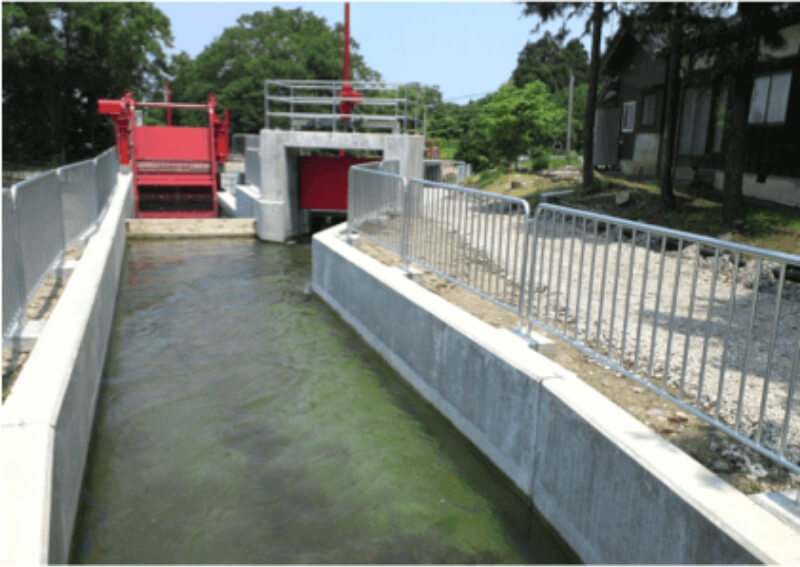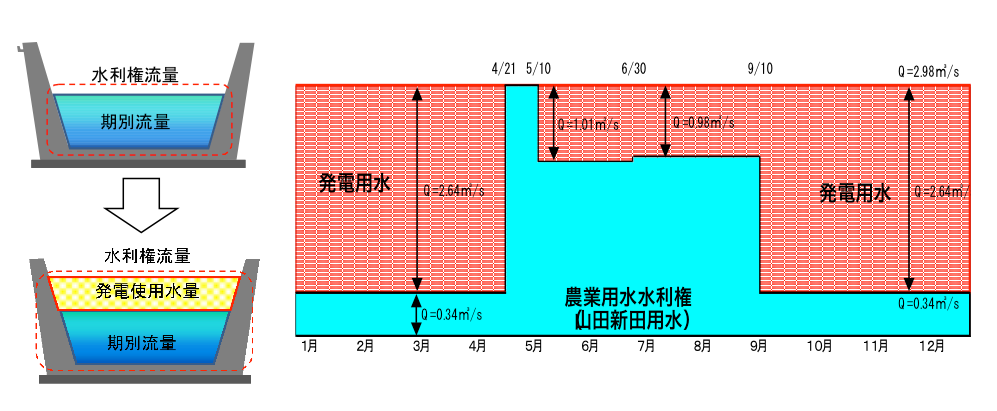Design of the Yamada Shinden District Small Hydro Power Plant
Small-to-Medium sized Hydroelectric Power Generation, Fiscal year 2010, Toyama Prefecture Tonami Promotion Center of Agricultural and Forestry

(1) Outline of project
In the planning and implementation of the power plant, we handled the basic design, implementation design, construction design, support for the preparation of various application materials, and supervision of construction work.
(2) Outline of generating electricity plan
The power plant uses a maximum of 2.64 m3/s of water. Water is guided from a water tank (head tank) down along a hydraulic pipeline over a length of approximately 350 m to a power generator, over an effective drop of 25.2 m, to generate a maximum of 520 kW of power. The plant is designed to supply a total of about 2.57 million kWh of electricity per year.
A maximum of 2.98 m3/s of the water drawn off from first Headworks on the Oyabe River is guided along the Yamada Shinden Water Channel. Priority is given to the feeding of water for irrigation, with the remaining water used for power generation at the Yamada Shinden Water Channel Power Plant. After power generation, the water is discharged back into the Oyabe River.
The water turbine is a horizontal Francis turbine, while the generator is a horizontal 3-phase induction generator.
The water diversion gate installed upstream of the head tank is controlled to give priority for irrigation, while the rest of the water is guided into the power generation plant.

(3) Features of the design project
1. Acquisition of new water use rights for power generation utilizing the surplus capacity of an existing irrigation canal.
Usually many small hydro power plants, which are built along irrigation canal, depend on flow rate which varies throughout the year.
This means it is difficult to generate in winter. In winter there can be barely enough water to maintain the irrigation canal, making power generation impossible. Therefore there is surplus capacity of the irrigation canal in the non-irrigation period, as shown in the cross section blow.
In order to enlarge water usage, we conducted a verification of the Oyabe river flow data to find necessary flow rate for river maintenance. The result is that we can draw off the maximum flow rate under the existing irrigation water use rights throughout the year.
As a result, we drew off the maximum flow rate throughout the year to generate power station on the condition that we give priority to irrigation. This is a distinctive power generation pattern in Japan.
(3) Features of the design project
1. Acquisition of new water use rights for power generation utilizing the surplus capacity of an existing irrigation canal.
Usually many small hydro power plants, which are built along irrigation canal, depend on flow rate which varies throughout the year.
This means it is difficult to generate in winter. In winter there can be barely enough water to maintain the irrigation canal, making power generation impossible. Therefore there is surplus capacity of the irrigation canal in the non-irrigation period, as shown in the cross section blow.
In order to enlarge water usage, we conducted a verification of the Oyabe river flow data to find necessary flow rate for river maintenance. The result is that we can draw off the maximum flow rate under the existing irrigation water use rights throughout the year.
As a result, we drew off the maximum flow rate throughout the year to generate power station on the condition that we give priority to irrigation. This is a distinctive power generation pattern in Japan.

2. Design of plant considered in landscaping and conscious enlightenment.
In the building design of the power plant, we modelled it on a traditional Japanese-style kura storehouse design, with careful consideration to the local landscape, as well as measures to prevent noise in the surrounding area.
We also gave careful thought to promoting understanding and conscious enlightenment about renewable energy and to providing an opportunity for children to learn about the environment, through the use of illustrations explaining the mechanism of power generation, and the installation of an electric light display board showing the quantity of electric power currently being generated.


3. Design, construction period and business profitability
This power generation plant initiative was adopted as a prefecture-managed “regional water environment improvement project” in fiscal 2010. Construction began in October 2011 and the plant began operating in March 2013. (Total project cost: 617 million yen)
Since the government’s feed-in tariff system (FIT) was introduced and put into effect during the construction period of this power plant, the generated power could be sold at a higher price than initially planned for, thereby making the power plant more profitable than expected.
Other reference diagrams


From the project head
Conventional plants depend on the variable flow rate throughout the year. On the contrary we made full use of canal capacity which requires new water use right. It was so unique that we had many difficulties relating to consultation and coordination on application for new water use right.
Since this plant is one of the most advanced small hydro systems utilizing irrigation water, I have heard that many people visit to observe this plant. So I think the project was worth the effort.
I engaged in whole process of the project. In this process I talked many constructors and learned the importance of workability oriented design.
Hydroelectric power generation design requires knowledge of civil engineering as well as electricity and construction, and collaboration with various manufacturers is also important. It is not something that can be done by a single person. I have realized acutely that cooparation, as a team, is vaitally important.
Masaki Nakano, Department of Second Civil Engineering Works

